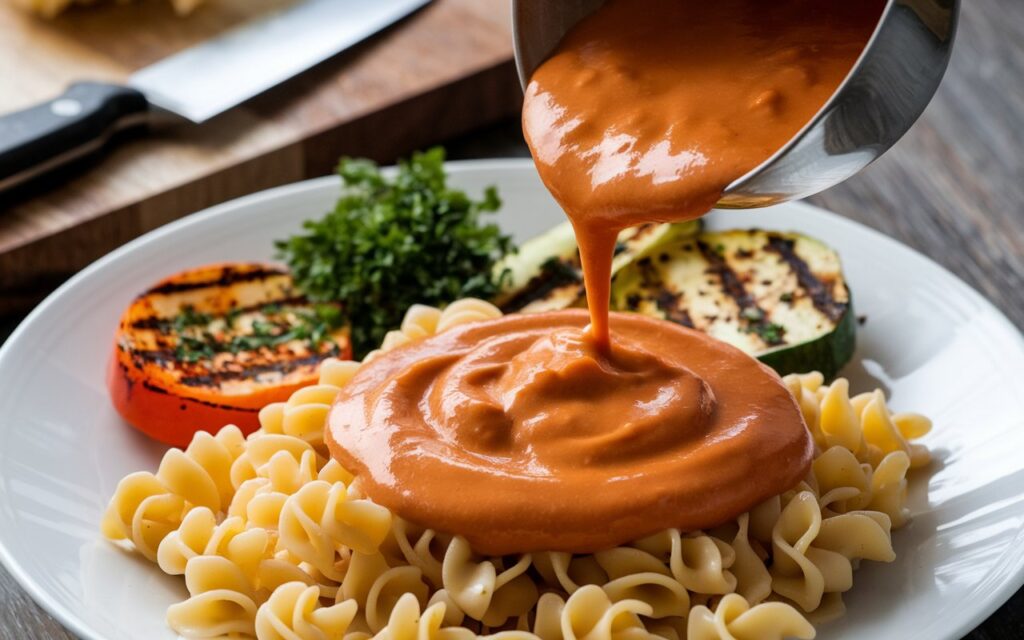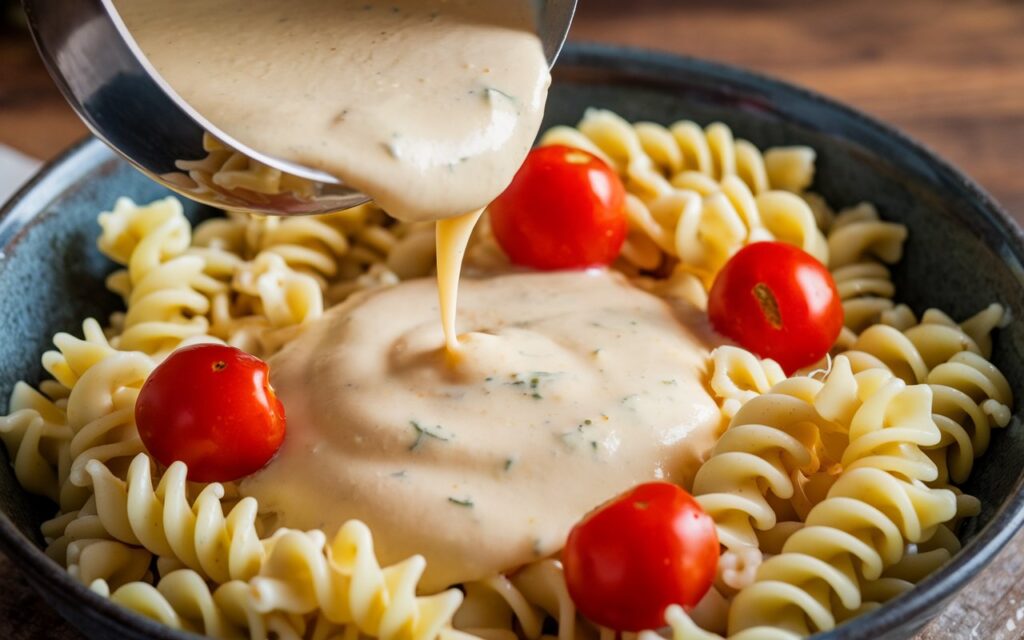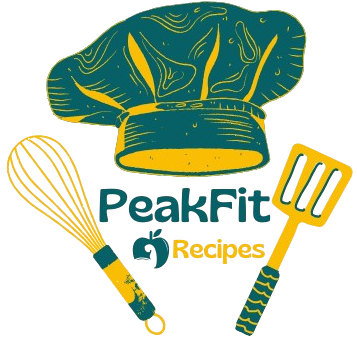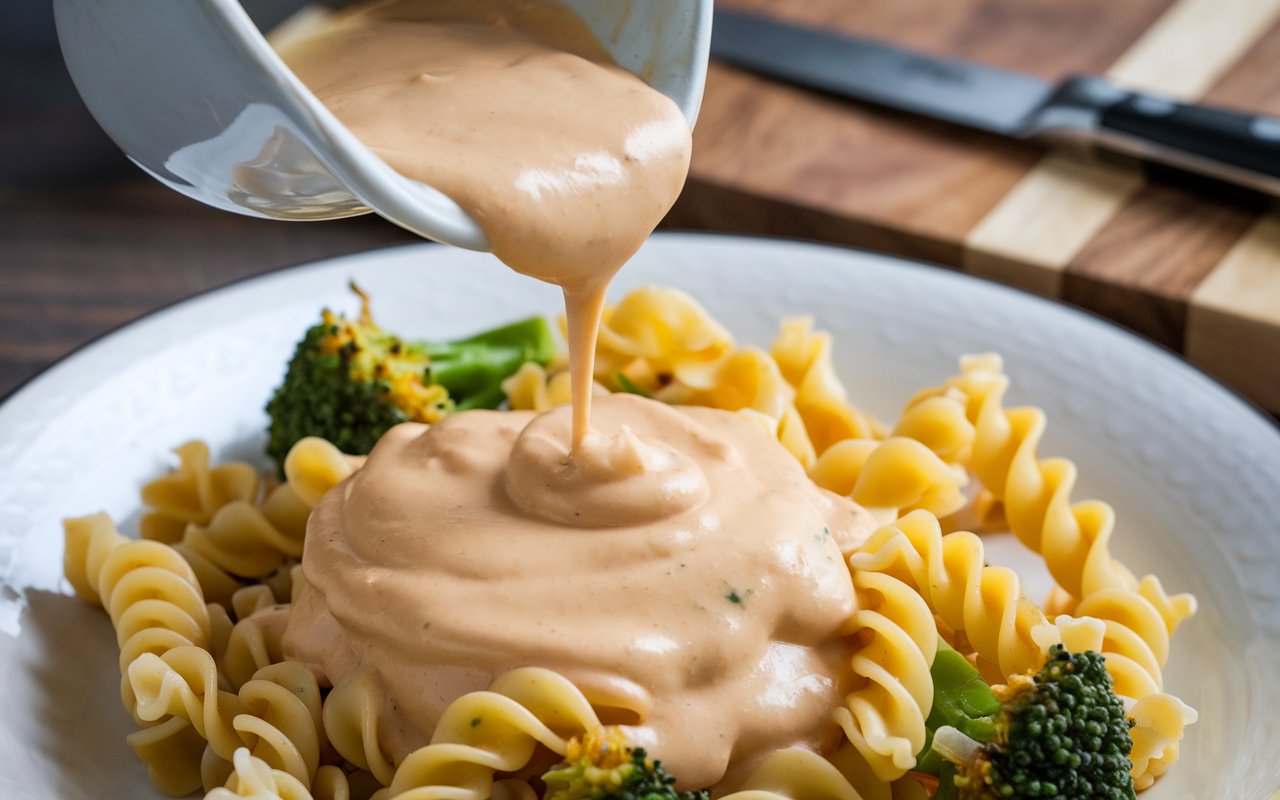Mac and cheese delights many as a classic comfort food. However, traditional recipes frequently use flour to thicken the cheese sauce. This reliance on flour can pose challenges for those with dietary restrictions or individuals looking for gluten-free alternatives. Thankfully, there are numerous substitutes available that create a creamy, rich sauce without using flour. Moreover, these alternatives often enhance the dish’s flavor and texture, making them excellent choices for experimenting with new mac and cheese recipes. Whether you’re out of flour, gluten-intolerant, or exploring alternative ingredients, there are plenty of options to create a creamy and delicious dish. This article will cover what you can use instead of flour in mac and cheese, offering practical tips, in-depth explanations, and alternative methods.
Introduction to Flour-Free Mac and Cheese
Cooks commonly use flour in mac and cheese recipes to create a roux, which thickens the sauce by combining flour and fat. However, while it creates a smooth sauce, there are many substitutes that achieve the same or even better results. For example, gluten-free alternatives like cornstarch or arrowroot powder can replicate the thickening properties without using flour. Moreover, healthier options such as Greek yogurt or heavy cream provide unique flavors and added nutrition. Ultimately, these substitutes ensure your mac and cheese remains creamy, flavorful, and satisfying, regardless of dietary restrictions or ingredient availability.
Why Avoid Flour in Mac and Cheese?
1. Dietary Restrictions
Flour contains gluten, which can therefore be problematic for people with gluten intolerance or celiac disease. As a result, avoiding flour allows you to cater to these dietary needs while still maintaining the dish’s flavor.
2. Carb Consciousness
For those on low-carb or keto diets, eliminating flour reduces carbohydrate content. Substitutes like cream cheese or heavy cream are excellent for maintaining a creamy texture while lowering carbs.
3. Ingredient Accessibility
Sometimes you may run out of flour and need a quick alternative. Many flour substitutes are common pantry staples, making them convenient and accessible.
4. Flavor Enhancements
Certain substitutes like cream cheese or Greek yogurt not only thicken the sauce but also add a unique depth of flavor, enhancing the dish’s overall taste.
Learn more about gluten-free cooking basics to accommodate dietary restrictions.
The Science Behind Thickening Agents
Cheese sauce requires a thickening agent to bind the milk, butter, and cheese together into a creamy consistency. Flour works by releasing starches when heated, creating a network that thickens the liquid. Substitutes achieve the same effect but rely on alternative properties like proteins or other starches. Understanding these substitutes helps you choose the best one for your mac and cheese.
Top Substitutes for Flour in Mac and Cheese
1. Cornstarch
Cornstarch is a popular and effective thickening agent, especially for gluten-free recipes. It thickens faster than flour and creates a smoother texture.
- How to Use: Mix 1 tablespoon of cornstarch with 2 tablespoons of water to create a slurry. Add the slurry to your sauce while stirring over medium heat.
- Pros: Gluten-free, flavorless, and creates a glossy finish.
- Cons: Can become gummy if overcooked.
Learn how people use cornstarch in other gluten-free dishes.
2. Potato Starch
Potato starch is another excellent thickener, especially for recipes requiring a creamier texture. It works similarly to cornstarch but has a slightly denser consistency.
- How to Use: Dissolve 1 tablespoon of potato starch in cold water. Add it to the cheese sauce while stirring.
- Pros: Gluten-free, flavor-neutral, and thickens quickly.
- Cons: Overheating can break down the starch.
3. Arrowroot Powder
Arrowroot is a plant-based thickener that is gaining popularity in gluten-free and paleo diets. It’s less processed than cornstarch and creates a smooth, shiny sauce.
- How to Use: Mix 1 teaspoon of arrowroot powder with 2 teaspoons of water, then stir into the cheese sauce over low heat.
- Pros: Paleo-friendly, gluten-free, and works well at low temperatures.
- Cons: Sauce may thin out if reheated.
4. Heavy Cream
Heavy cream is an excellent alternative to flour and roux-based sauces. It thickens naturally as it simmers and eliminates the need for additional thickeners.
- How to Use: Replace the milk and flour mixture with heavy cream. Cook over medium heat until the cream reduces slightly, then add cheese.
- Pros: Rich, creamy, and easy to use.
- Cons: Higher in fat and calories.
5. Cream Cheese
Cream cheese thickens sauces while adding a tangy flavor. It’s perfect for creating a luxurious texture in mac and cheese.
- How to Use: Whisk 4 ounces of softened cream cheese into warm milk before adding shredded cheese.
- Pros: Thickens and flavors the sauce simultaneously.
- Cons: Adds a tangy taste that may not suit all recipes.
6. Greek Yogurt
Greek yogurt offers a healthier alternative to flour, adding creaminess and a protein boost to the dish.
- How to Use: Stir ½ cup of Greek yogurt into the sauce after removing it from heat.
- Pros: Low-fat and protein-rich.
- Cons: Adds a tangy flavor.
Other Creative Substitutes
Tapioca Starch
Derived from cassava, tapioca starch creates a stretchy texture ideal for mac and cheese.
Cauliflower Puree
Blended cauliflower acts as a natural thickener and adds a serving of vegetables to the dish.
Almond Flour
For a nutty twist, almond flour works as a gluten-free alternative for roux-based sauces.
Step-by-Step Recipe for Flour-Free Mac and Cheese
Ingredients
- 8 oz pasta (gluten-free if needed)
- 2 cups shredded cheddar cheese
- 1 cup shredded mozzarella cheese
- 2 cups milk or heavy cream
- 2 tbsp butter
- 1 tbsp cornstarch or other substitute
- Salt and pepper to taste
Directions
- Cook the Pasta: Boil the pasta according to package instructions, then drain and set aside.
- Prepare the Sauce: Melt butter in a saucepan. Add your chosen thickener and stir until smooth.
- Add Milk: Gradually whisk in milk or cream, cooking until slightly thickened.
- Incorporate Cheese: Stir in shredded cheese until fully melted and creamy.
- Combine: Toss the pasta with the sauce and serve hot.
Tips for Perfect Flour-Free Mac and Cheese
- Use room-temperature ingredients for a smoother sauce.
- Cook the sauce over medium heat to prevent curdling.
- Add spices like paprika or garlic powder for extra flavor.

The Role of Flour in Traditional Mac and Cheese
Flour plays a key role in traditional mac and cheese recipes, serving as the foundation for creating a creamy and cohesive cheese sauce. Understanding its function helps explain why substitutes are necessary and how they work to achieve similar results. Let’s break down why flour is essential in classic mac and cheese and what happens when it’s omitted.
Why Use Flour in Mac and Cheese?
Flour is most commonly used in mac and cheese to create a roux. A roux is a mixture of flour and fat (usually butter) cooked together, which acts as a thickening agent for the cheese sauce. This process is essential for achieving the smooth and creamy texture that defines great mac and cheese.
1. Thickening the Sauce
When flour is combined with butter and cooked, it forms a paste-like consistency. Adding milk or cream to this roux allows the starch in the flour to absorb the liquid, resulting in a thickened sauce. This step ensures the cheese sauce clings to the pasta, creating a cohesive dish.
2. Preventing Cheese Separation
Without a roux, cheese tends to separate when melted, leading to a grainy or oily texture. The starches in flour stabilize the cheese by creating a uniform base that keeps the fats and proteins in the cheese emulsified.
3. Adding Structure to Baked Versions
In baked mac and cheese recipes, flour provides additional structure to the dish. It helps the sauce set during baking, ensuring a firm yet creamy consistency that holds together when served.
How Flour Works as a Thickener
Flour thickens the cheese sauce through the release of starches. Here’s how it works step-by-step:
- Cooking the Roux: Cooking flour with butter neutralizes its raw taste and activates the starch molecules. This step ensures the sauce is flavorful and smooth.
- Adding Liquid
When you gradually add liquid, such as milk or cream, to the roux, the starch molecules actively absorb the liquid and swell. This process creates a thickened base that forms the foundation of the sauce.
Incorporating Cheese
After thickening the base, you should add shredded cheese and allow it to melt. The thickened sauce actively prevents the cheese from clumping or becoming oily, ensuring a smooth and creamy texture.
Challenges of Using Flour
While flour is a traditional thickener, it does come with certain limitations:
- Gluten Sensitivity
Flour contains gluten, making it unsuitable for people with celiac disease or gluten intolerance. - Flavor Dilution
Some argue that flour slightly mutes the cheese flavor, as it creates a starchy base. - Time-Consuming
Making a roux requires extra cooking time and precise technique to avoid lumps or burning.
Modern Alternatives to Flour in Mac and Cheese
With more people seeking gluten-free or low-carb options, flour is no longer the only choice for thickening cheese sauce. Substitutes like cornstarch, potato starch, and heavy cream offer quick, gluten-free, and flavorful alternatives. These options replicate the thickening properties of flour without compromising dietary restrictions or taste.
For more on flour substitutes, check out our section on Top Substitutes for Flour in Mac and Cheese.
Regional Variations of Mac and Cheese
Mac and cheese delights people across the globe, but the way it’s prepared changes significantly depending on the region and culture. Cooks in the Southern U.S., Italy, and France, for example, showcase unique local ingredients, traditions, and preferences in their versions of the dish. Let’s explore some popular regional adaptations and learn how to create them without flour.
1. Southern Baked Mac and Cheese
In the Southern United States, baked mac and cheese is a cornerstone of comfort food and soul food traditions. Unlike stovetop versions, this variation is often made with eggs, evaporated milk, and a mix of cheeses, resulting in a firmer, custard-like texture.
- How It’s Made:
Southern mac and cheese typically skips a roux and relies on eggs to thicken the dish. Layers of cooked macaroni are combined with cheese and poured over with a custard mixture before baking until golden and bubbly. - Flour-Free Adaptation:
Use heavy cream and eggs to thicken the custard base. For extra flavor, include sharp cheddar, Monterey Jack, or Colby cheese.
2. Italian Mac and Cheese (Maccheroni al Formaggio)
In Italy, the closest cousin to mac and cheese is “maccheroni al formaggio,” which often features béchamel sauce as a base. This creamy white sauce is made with butter, flour, and milk, then mixed with pasta and cheese.
- How It’s Made
- Combine the béchamel with cheeses like Parmesan or fontina, and fold it into the cooked pasta. For a crispy top, bake the dish in the oven.
- Flour-Free Adaptation:
Replace the béchamel with heavy cream or a combination of cream cheese and milk. Use Parmesan and mozzarella for a rich and stretchy texture.
3. French-Inspired Mac and Cheese (Gratin de Macaroni)
In France, mac and cheese often takes the form of “gratin de macaroni,” a decadent dish baked with béchamel sauce and gruyère cheese. It’s served as a luxurious side dish or a main course.
- How It’s Made:
Macaroni is coated in a thick, creamy béchamel, layered with shredded gruyère, and baked until golden. Some variations include breadcrumbs for a crunchy topping. - Flour-Free Adaptation:
Skip the béchamel and use a roux-free sauce with gruyère and cream. For added richness, consider incorporating truffle oil or nutmeg.
4. Jamaican Macaroni Pie
Jamaican mac and cheese, or macaroni pie, is a Caribbean twist on the classic dish. It’s known for its bold flavors and dense, baked texture.
- How It’s Made:
Cooked macaroni is combined with cheddar cheese, eggs, milk, and spices like paprika, black pepper, and sometimes Scotch bonnet peppers for heat. - Flour-Free Adaptation:
Use eggs and evaporated milk as the base to bind the macaroni and cheese. Add a touch of cayenne or jerk seasoning for a spicy kick.
5. British Cauliflower Cheese
In the UK, cauliflower cheese is a popular variation that often serves as a side dish. While it’s not strictly mac and cheese, the concept is similar, with a cheese sauce poured over cauliflower florets.
- How It’s Made:
Traditionally, a roux-based cheese sauce is poured over cooked cauliflower, topped with breadcrumbs, and baked until golden. - Flour-Free Adaptation:
Use heavy cream or Greek yogurt to thicken the cheese sauce. Pair with cheddar and Stilton for a distinctively British flavor profile.
6. Nordic-Style Mac and Cheese
In Nordic countries, mac and cheese is often less creamy and more focused on hearty, baked dishes with simple ingredients like butter, cream, and cheese.
- How It’s Made:
Pasta is mixed with cheese and cream, baked until set, and served as a cozy, filling meal. - Flour-Free Adaptation:
Use full-fat cream and mild Scandinavian cheeses like Havarti or Jarlsberg. Add a pinch of dill or chives for a Nordic twist.
7. South African Mac and Cheese (Macaroni Pudding)
South African mac and cheese often resembles a sweet and savory pudding. It’s made with sugar, eggs, and milk, and baked into a custard-like consistency.
- How It’s Made:
The macaroni is mixed with a custard base and topped with cheese, sometimes including savory ingredients like ham or bacon. - Flour-Free Adaptation:
Use eggs and condensed milk for a rich custard base. Mix in shredded cheese and optional savory elements for balance.
8. German Käse-Spätzle
Although it is not traditional mac and cheese, Germany’s käse-spätzle features spätzle (small egg noodles) and cheese. Chefs often top it with caramelized onions.
- How It’s Made:
Spätzle is layered with cheese, often Emmental or Swiss, and baked or served fresh with onions. - Flour-Free Adaptation:
Skip the spätzle and use gluten-free pasta. Replace flour-thickened sauces with heavy cream and shredded cheese.
9. Modern American Gourmet Mac and Cheese
In the United States, modern gourmet versions of mac and cheese are popular in upscale restaurants. These include additions like lobster, truffle oil, or exotic cheeses.
- How It’s Made
- Prepare a cheese sauce by mixing premium cheeses until smooth. Combine the sauce with pasta, then bake the dish. Finally, top it with breadcrumbs for a crispy finish.
- Flour-Free Adaptation:
Use a blend of cream, mascarpone, and smoked cheeses like gouda or gruyère. Add lobster or truffle oil for a luxurious finish.

FAQs
What Can You Substitute Flour For in Mac and Cheese?
When it comes to thickening mac and cheese, several substitutes work perfectly in place of flour. Cornstarch, arrowroot powder, and potato starch are excellent alternatives. Additionally, these options are gluten-free and easy to use, making them ideal for those with dietary restrictions. Furthermore, they create a smooth and creamy texture without altering the flavor of your dish.
What Can I Use Instead of Flour in Cheese Sauce?
If you’re making cheese sauce and want to avoid flour, you have several great options. For example, cream cheese, heavy cream, or Greek yogurt can serve as effective thickening agents. Moreover, these alternatives not only thicken the sauce but also add richness and depth of flavor. Consequently, you can enjoy a more luxurious mac and cheese without using flour.
Can You Make Mac and Cheese Without Flour on Reddit?
Yes, absolutely! Many Redditors have shared tips and tricks for making mac and cheese without flour. For instance, they often recommend using cornstarch as a reliable thickener. Alternatively, some suggest skipping thickening agents altogether by relying on heavy cream for a naturally rich and creamy consistency. Therefore, it’s clear that flour isn’t necessary to achieve a delicious mac and cheese.
How to Thicken Cheese Sauce Without Flour or Cornstarch?
If you’re looking for a way to thicken cheese sauce without flour or cornstarch, don’t worry—there are other methods. Heavy cream is an excellent option, as it thickens naturally when simmered. Additionally, you can reduce the sauce by cooking it over low heat, which concentrates its flavors while achieving the desired thickness. Ultimately, these techniques ensure a velvety cheese sauce without relying on traditional thickeners.
Conclusion
Mac and cheese is a beloved dish that not only transcends borders but also adapts beautifully to various dietary preferences. Whether you’re avoiding flour for health reasons, exploring new culinary techniques, or simply out of traditional ingredients, there are countless ways to create a rich, creamy, and delicious version of this comfort food. In addition, regional variations like Southern-style baked mac and cheese, elegant French gratins, or even vegan and low-carb adaptations offer a unique twist on this classic favorite.
By understanding the role of thickening agents and experimenting with substitutes like cornstarch, heavy cream, or cream cheese, you can easily customize mac and cheese to suit your taste and dietary needs. Furthermore, incorporating your favorite toppings or regional flavors makes the dish even more enjoyable. So go ahead, try a new regional style, add a creative topping, and make a mac and cheese that’s not only delicious but also uniquely yours.

